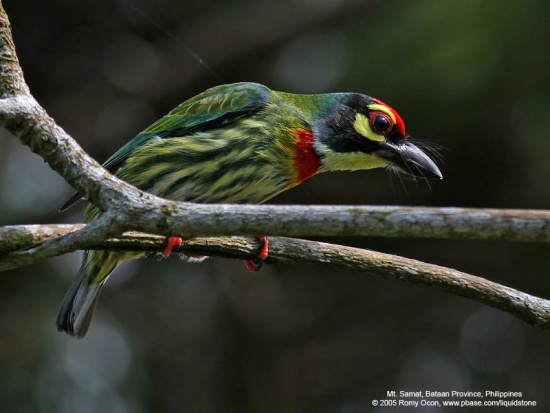- Megalaima haemacephala
Identification
Smallest barbet at 17 cm. The dark, stout bill is fringed with bristles or barbs, which give the barbets their name. It is brightly coloured, with red legs and feet; bright green upperparts; greenish white underparts with diagnostic bold green streaks; black-bordered yellow face with black eye stripes, red forecrown and throat patch. Sexes are alike.
Distribution
The most common and widespread of the barbets found in India, through south China and South-east Asia through Sumatra, Java, Bali and the Philippines.
Taxonomy
A member of the Megalaimidae family (Statius Muller, 1776). There are 9 subspecies: M. h. cebuensis, M. h. celestinoi, M. h. delica, M. h. haemacephala, M. h. homochroa, M. h. indica, M. h. intermedia, M. h. mindanensis, M. h. rosea.
Habitat
Mangroves edges, open country, wooded gardens even towns and cities.
Behaviour
Perches on bare branches or high tension wires, in groups, often up to six. Unlike its larger congeners it does not always frequent the canopy but will often feed low on small fruits in tree and brushs. Prefers Banyan, Peepul, and other wild figs, various drupes and berries, with the occasional insect, caught clumsily in flight. Flight is straight with rapid wing beats.
Breeding: from November to June, mainly from February to April. The nest is in a hole, excavated in a decaying or dead tree or branch, about 40 cm deep. There are 2-4 white eggs, usually 3, laid on the bare wood. The length of incubation is not known. Both partners help with nest duties.
Voice: call is a loud, rather metallic tuk tuk tuk (or tunk), sounding rather like a copper sheet being beaten, which accounts for it's name. The call is repeated monotonously for long periods, beginning with a subdued tuk and then building up to an even tempo and volume, the former varying from 1.5 to 2 per second. The bill stays shut during each call and a patch of bare skin either side of the throat inflates and deflates with each tuk call. Body and tail shaking accompanies the calling. The birds are not very vocal in cold weather, so they are silenced by a spell of rain or cold. In India, this bird's call is one of the most familiar sounds in the hot season.




